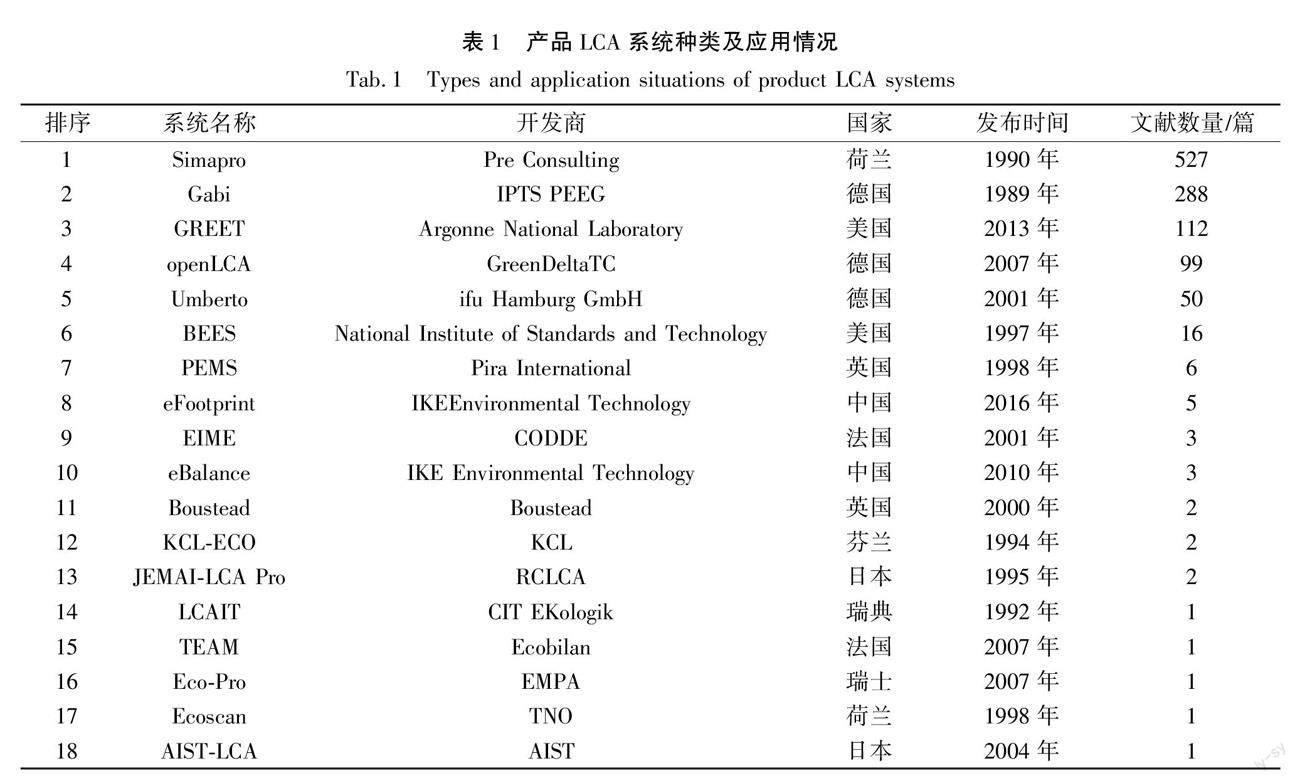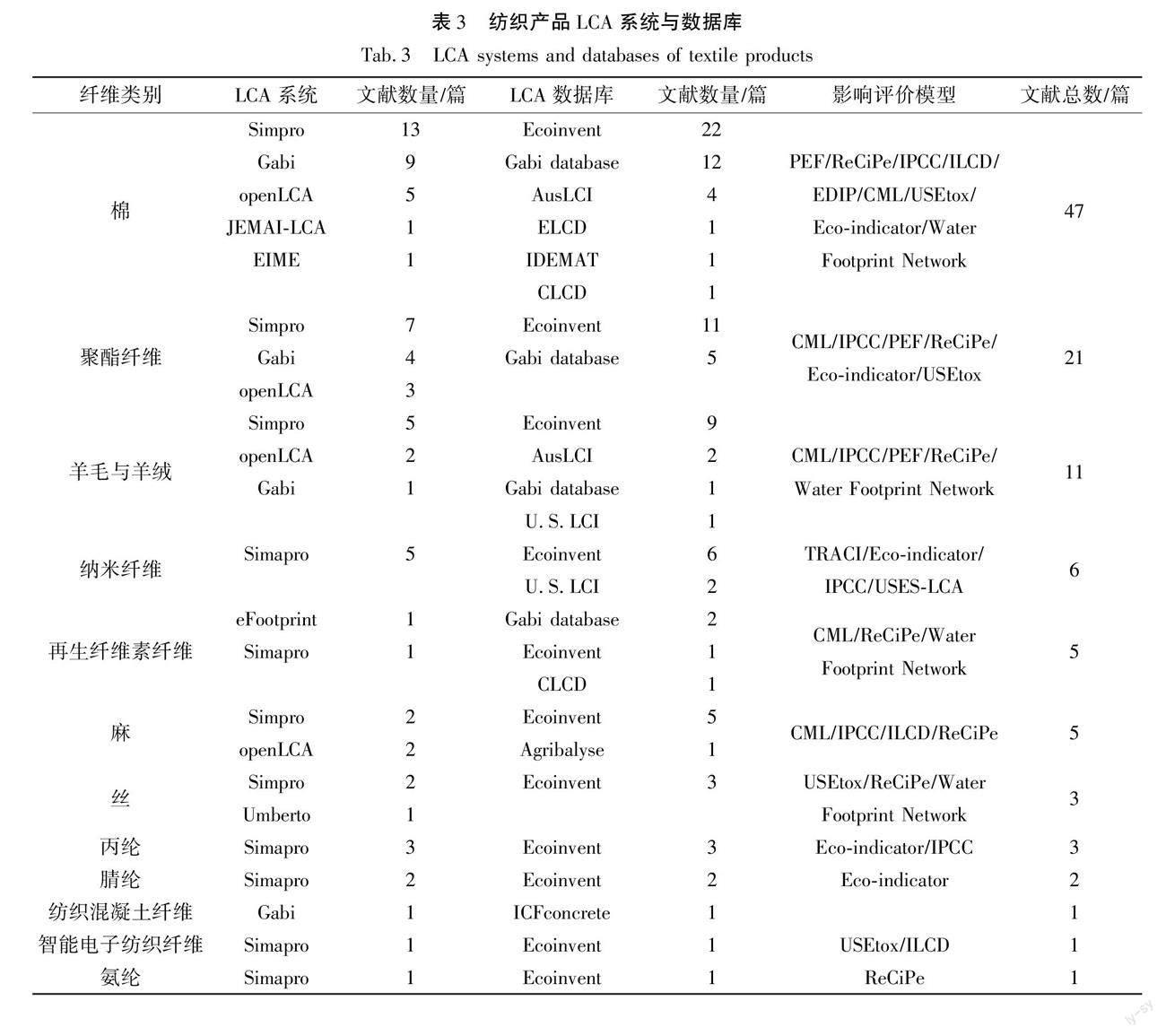纺织产品生命周期评价系统与数据库分析
邬崇振 李启正 刘灿 王来力



摘 要:产品生命周期评价系统和数据库为高效、准确开展产品生命周期评价提供数据处理、结果量化和评价支撑。本文对纺织产品生命周期评价研究文献中应用的生命周期评价系统与数据库系统界面、数据库和影响评价模型数量、特征化因子、归一化因子、权重因子等进行了系统分析。结果表明:Simapro系统和Gabi系统是纺织产品生命周期评价案例使用最多的系统,总占比为53.77%;Ecoinvent数据库和Gabi数据库是纺织产品生命周期评价案例使用最多的数据库,总占比为79.24%;Simapro系统和Gabi系统内置数据库有相同种类但数值不同的特征化因子、归一化因子、权重因子,导致使用两个系统针对同一纺织产品的生命周期评价结果存在差异;综合考虑污染物排放渠道和区域内生产规模、科技水平、经济状况、环保政策等因素,构建具有国家、区域、时间性质的纺织产品LCA数据库可以提高评价结果的完整性和准确性。
关键词:纺织产品; 生命周期评价; 评价系统; 影响评价;清单数据库
中图分类号:TS101
文献标志码:A
文章编号:1009-265X(2023)04-0029-08
收稿日期:2022-12-16
网络出版日期:2023-02-23
基金项目:中国工程院战略研究与咨询项目(2022-XY-19); 中央外经贸专项资金(茧丝绸)项目(浙财建[2022]95号)
作者简介:邬崇振(1998—),男,江西丰城人,硕士研究生,主要从事纺织产品碳足迹核算与评价方面的研究。
通信作者:李启正,E-mail:liqizheng@zstu.edu.cn
生命周期评价(Life cycle assessment, LCA)是1990年美国环境毒理和化学学会提出的一种识别产品或工艺在整个生命周期中对环境影响的综合方法,可以确定产品生命周期环境影响的关键阶段,从而为制定节能减排策略提供重要的指导作用[1]。产品LCA包括确定目标和范围、清单分析、影响评估、结果解释,通常涉及原料生产、产品制造、运输、消费、废弃物处置等生命周期过程[2]。数据收集与结果评价是产品LCA的两个关键环节,使用评价系统和其内置的能源、物料等投入清单的影响因子数据库可提升产品生命周期评价的效率[3]。
中国是纺织产品的生产和消费大国,通过对纺织产品进行生命周期评价可以量化纺织产品生产和消费产生的环境影响,进而为绿色低碳纺织产品设计、生产和消费提供参考[4]。笔者梳理了产品LCA系统与数据库应用情况,并就纺织产品LCA研究文献中应用的生命周期评价系统与数据库的系统界面、数据库和影响评价模型数量、特征化因子、归一化因子、权重因子等进行了系统分析,为纺织产品生命周期评价提供参考。
1 生命周期评价系统与数据库
对中国知网和Web of Science核心数据库中关于产品LCA研究文献进行检索,并对文献中应用的产品LCA评价系统和数据库进行汇总,结果见表1和表2。
产品LCA研究需要经过复杂繁琐的建模流程和庞大的计算过程,使用LCA系统可以快速、准确地建立产品生命周期模型并量化环境影响[5]。从表1可知,1120篇文献中共涉及18个LCA系统,527篇产品LCA研究文献中应用了Simapro系统,应用最多,其次是Gabi系统和GREET系统,分别有288篇和112篇,3个系统的文献占比分别为47.05%、25.71%和10%。18个LCA系统的开发时间分布于1989—2016年,开发和应用最早的是1989年发布的Gabi系统。LCA系统在开发运行后会进行持续更新,例如Simapro系统最新一次更新是2022年5月发布的9.4.0.1版本,该版本更新了Agri-footprint数据库,增加了1165个清单数据;更新了IPCC影响评价模型,增加了64种物料的特征因子;新增了Ecological scarcity、Land use impacts on biodiversity影响评价模型[6-8]。
产品LCA研究需要大量产品的表层清单数据和背景清单数据,使用LCA数据库可以增加数据收集的效率,提高评价结果的可信度和可比性[9]。由表2可知,715篇文献中共涉及22个生命周期评价数据库,其中Ecoinvent数据库在产品LCA应用最多,有342篇,占比为47.83%。其次是Gabi数据库、U.S.LCA数据库和EXIOBASE数据库,分别有173篇、60篇和40篇,占比分别约为24.20%、8.39%和5.59%。LCA数据库的开发时间分布于1989—2020年,1989年发布的Gabi是开发最早的LCA数据库。数据采集覆盖的地域范围越广,其评价结果越可靠[7]。若地域范围的区域特性突出,清单数据无法匹配其他区域内的实际生产情景,会增加评价结果的不确定性[10]。LCA数据库集成在LCA评价系统中,例如Simapro系统集成了
Ecoinvent、IDEMAT、Agribalyse 等数据库,Gabi系统集成了Gabi、Ecoinvent、ICFconcrete等数据库。对产品LCA研究可以使用LCA系统调用一个或多个LCA数据库的数据,也可以单独导出LCA数据库中的数据进行环境影响评价[11]。
2 纺织产品生命周期评价与数据库
纺织产品生命周期过程包括纤维原材料获取、产品生产加工、运输销售、产品使用和废弃处理,涉及多种物料、能源的投入,并产生多种污染物,对生态环境产生影响[12]。纺织产品的LCA受到越来越多的关注和研究,对纺织产品LCA研究文献进行检索,并对其中应用的评价系统和数据库进行分析,结果见表3。
由表3可知,紡织产品LCA研究文献中有106篇应用了评价系统与数据库。Simapro系统在纺织产品LCA研究中应用最多,占比约为39.62%,其次是Gabi系统,占比约为14.15%,openLCA系统占比约为11.32%,Umberto、eFootprint、JEMAI-LCA、EIME系统的应用较少。在评价数据库方面,Ecoinvent数据库在纺织产品LCA研究中应用最多,占比约为60.37%,其次是Gabi数据库,占比约为18.87%,AusLCI数据库、U.S.LCI数据库、CLCD数据库等应用较少。
2.1 系统界面
LCA系统的核算界面有树形界面、流程图界面和桑基图界面。树形界面基于区域数据可视化,获取大型分层数据的层次结构和单个数据点的值,适用于结构化产品工艺建模。流程图界面强调相邻两个工序之间的联系,突出执行的先后顺序,适用于流程化产品工艺建模。桑基图提供了可视化功能和动态输入变化,将物料输入和能源消耗动态表示出来。使用桑基图建模时,桑基箭头的宽度取决于物料输入或能源消耗的质量,并且当节点上产生输入输出差异时,会自动标红报警。纺织产品LCA研究应用的系统核算界面见表4。
由表4可知,Simapro系统、EIME系统、eFootprint系统、采用树形界面,JEMAI-LCA系统和openLCA系统采用流程图界面,Gabi系统和Umberto系统采用桑基图界面。Simapro系统的树形结构可以从原料生产、纤维加工、织物织造、销售使用、废弃处理等多阶段对纺织产品的物料消耗及制造工序的能源消耗进行分析,从而能更清晰地发现纺织产品各阶段环境影响的区别。Gabi系统的桑基图是最直观的、最具有动态性的建模图形界面,可以应用于生产工艺多样且复杂的纺织产品LCA研究[13]。Simapro系统和Gabi系统内置的Ecoinvent数据库、Gabi数据库、IDEMAT数据库包含了大部分纺织产品LCA所需物料和能源的清单数据,因此在纺织产品LCA研究中Simapro系统和Gabi系统应用最为广泛。
2.2 数据库和影响评价模型数量
LCA系统内置数据库和影响评价模型数量直接决定LCA结果的全面性和准确性,因此对纺织产品LCA數据库和影响评价模型数量进行比较,见表5。
由表5可知,Simapro系统和Gabi系统内置的数据库种类和影响评价模型的数量最多且差值较大,原因之一是Simapro系统和Gabi系统会保留版本更新前的影响评价模型,而其他LCA系统会用新的影响评价模型取代旧版本的影响评价模型。Siamapro系统与Gabi系统的影响评价模型与其他系统的openLCA系统没有自带数据库,需要去其官网下载LCA数据库,其中4个数据库免费使用,其余16个数据库需要付费使用。Gabi系统只有Gabi教育版数据库可以免费使用,其他数据库均需付费。Simapro系统可免费使用部分Ecoinvent数据库进行生命周期评价,其他数据库需要付费使用。研究者在使用Gabi系统、Simapro系统或者openLCA系统进行产品LCA时[14],如果背景清单繁多,一个数据库中并没有包含所有的数据清单,通常采用混合式LCA数据库来进行核算,也即使用两个或两个以上LCA数据库进行核算,导致研究者会使用非本地区的数据来计算,造成LCA结果出现误差。
2.3 纺织产品主要LCA系统比较
不同的LCA系统对同一纺织产品进行LCA评价,得到的LCA评价结果不同。纺织产品使用的LCA系统以Simapro系统和Gabi系统为主,因此对Simapro系统和Gabi系统比较[15-20],见表6。
Simapro系统可以联网多用户使用,在同一项目或同一数据库进行协同工作。而Gabi系统是封闭
式工作,互动性低,耗时长。此外,LCA系统使用的LCIA模型不同,也会对评价结果产生影响[21]。例如,气候变化类别有不同的度量标准,这些度量标准因所考虑的时间段(20年、100年或500年)或指标(辐射强迫增加或温度增加)而参数不同。各种供应商以LCI数据库的形式提供辅助数据。流程建模有不同的方法。不同的系统边界、假设以及数据集的时空有效性会导致不同的结果[22]。因此使用者可以匹配自身需求,确定核算边界,理清产品组成,明晰数据来源,选择与核算数据时间、区域来源相近的LCA系统进行核算。
2.4 特征化因子
特征化因子是将同种环境影响类型的生命周期清单分析结果转化成具有相同单位的特征化指标的因子。特征化指标的值是后续影响评价的重要部分[23]。LCA系统内置数据库之间往往是有相同种类、数值却不同的特征化因子。以纺织产品LCA研究中应用广泛的的Simapro系统和Gabi系统为例,对两个评价系统内ReCiFe2016数据库的纺织产品相关因子进行比较,见表7。
由表7可知,Simapro系统中的氟氯氰菊酯的特征因子比Gabi系统大,相差645倍。其次为氟蚁腙,两个系统的海洋毒性特征化因子相差370倍。产生差异的原因之一是Simapro系统和Gabi系统分别由不同机构开发,在产品工艺流程的废弃物排放渠道选择上存在差异,Simapro系统中氯氰菊酯和α-氯氰菊酯的废弃物排放渠道是排放到水体,而Gabi系统中氯氰菊酯和α-氯氰菊酯的废弃物排放渠道是排放到大气。
2.5 归一化因子
归一化因子是一个区域内一年各项影响类型的特征化指标,与特征化结果的比值结果为无量纲数据,其结果可以帮助识别产品的主要影响类型[24]。LCA系统内置数据库之间同样存在具有相同种类、数值却不同的归一化因子的情况。对Simapro系统和Gabi系统内EDIP模型的归一化因子进行比较,见表8。
由表8可知,Simapro系统中水体富营养化潜值归一化因子比Gabi系统大,相差5.97倍。其次是酸化潜值、臭氧消耗潜值,分别相差4.58倍和4.02倍。产生差异的原因之一是Simapro系统和Gabi系统的开发商所在地区的生产规模和科技水平不同,对同种环境影响实施的对策有差异,导致Gabi系统的归一化因子小于Simapro系统的归一化因子[25]。
2.6 加权因子
加权因子是将归一化结果转化成不同影响类型的加权综合指标因子。其结果可以用于比较单一产品工艺流程环境影响的大小,也支持不同产品的环境影响评价[26]。Simapro系统和Gabi系统中集成的ReCiFe2016数据库中,Simapro系统的人体健康损害、生态环境损害、资源消耗等加权因子比Gabi系统小,差值均为0.99667倍。产生差异的原因之一是加权因子是折算因子,可以通过专家调查法和基于志愿支付法得出,前者通过询问一组专家的意见,得出各种环境影响类型或损害的重要性评分,后者通过被调查者用经济价值衡量各环境类型或损害的重要性[27]。
3 结 论
本文对产品LCA研究文献中的LCA系统和数据库进行了梳理,并对其在纺织产品LCA研究应用时的特征化因子、归一化因子和加权化因子等关键问题进行了分析讨论,结论如下:
a)纺织产品LCA研究文献中使用最多的LCA系统是Simapro系统和Gabi系统,总占比约为53.77%。使用最多的LCA数据库是Ecoinvent数据库和Gabi数据库,总占比约为79.24%。
b)各主要LCA系统与数据库的特征化因子、归一化因子、权重因子不一致,数据库與影响评价模型数量不同,导致针对同一纺织产品使用不同LCA系统和数据库进行LCA研究时,结果存在差异。
c)LCA系统与数据库的污染物排放渠道和区域内生产规模、科技水平、经济状况、环保政策的差别是使用不同LCA系统对纺织产品进行LCA研究时结果存在差异的主要原因。为提高纺织LCA结果的准确性,应建立统一的纺织产品LCA模型和具有区域性质、基准统一的LCA数据库。
参考文献:
[1]HURNI H, GIGER M, LINIGER H, et al. Soils, agriculture and food security: The interplay between ecosystem functioning and human well-being[J]. Current Opinion in Environmental Sustainability, 2015, 15:25-34.
[2]袁琳琳,姚庆达,但年华,等.铬鞣黄牛革全生命周期评价[J].皮革科学与工程,2021,31(4):11-16.
YUAN Linlin, YAO Qingda, DAN Nianhua, et al. Life cycle assessment evaluation of chrome tanned cattle leather[J]. Leather Science and Engineering, 2021, 31(4): 11-16.
[3]王玉涛,王丰川,洪静兰,等.中国生命周期评价理论与实践研究进展及对策分析[J].生态学报,2016,36(22):7179-7184.
WANG Yutao, WANG Fengchuan, HONG Jinglan, et al. The development of life cycle assessment theory research in China and analysis of countermeasures[J]. Acta Ecologica Sinica, 2016, 36(22): 7179-7184.
[4]ASTUDILLO M F, THALWITZ G, VOLLRATH F. Life cycle assessment of Indian silk[J]. Journal of Cleaner Production, 2014, 81: 158-167.
[5]王赛赛,吴雄英,丁雪梅.三种LCA核算软件对印花布碳足迹核算的比较[J].印染,2014,40(18):41-44.
WANG Saisai, WU Xiongying, DING Xuemei. Comparison of the industrial carbon footprint of printed fabrics using three LCA accounting software[J]. China Dyeing & Finishing, 2014, 40(18): 41-44.
[6]GOEDKOOP M, OELE M, EFFTING S. What's new in Simapro 9.4[EBOL]. [2022-5-31].https:support.simapro.comarticlesArticleRelease-Notes.
[7]CHAUDHARY A, VERONES F, DE BAAN L, et al. Quantifying land use impacts on biodiversity: Combining species-area models and vulnerability indicators[J]. Environmental science & technology, 2015, 49(16): 9987-9995.
[8]LAMBRECHT H, LEWERENZ S, HOTTENROTH H, et al. Ecological scarcity based impact assessment for a decentralised renewable energy system[J]. Energies, 2020, 13(21): 5655.
[9]GOEDKOOP M, OELE M, EFFTING S. Simapro Database Manual Methods Library. Netherland: PRe.Consultants[EBOL]. [2022-5-31]. http:www.pre.nlsimapro impact_assessment_methods.html.
[10]丰翔,孙丽蓉,朱紫嫄,等.纺织产品生命周期评价研究进展[J].印染助剂,2022,39(10):1-6.
FENG Xiang, SUN Lirong, ZHU Ziyuan, et al. Research progress of textile products life cycle assessment[J]. Textile Auxiliaries, 2022, 39(10): 1-6.
[11]KAZAN H, AKGUL D, KERC A. Life cycle assessment of cotton woven shirts and alternative manufacturing techniques[J]. Clean Technologies and Environmental Policy, 2020, 22(4): 849-864.
[12]GOMES-CAMPOS A, VIALLE C, ROUILLY A, et al. Flax fiber for technical textile: A life cycle inventory[J]. Journalof Cleaner Production, 2021, 281: 125177.
[13]ORMAZABAL M, JACA C, PUGA-LEAL R. Analysis and comparison of life cycle assessment and carbon footprint software[C]Proceedings of the Eighth International Conference on Management Science and Engineering Management. Berlin, Heidelberg: Springer, 2014: 1521-1530.
[14]SALIERI B, STOUDMANN N, HISCHIER R, et al. How relevant are direct emissions of microplastics into freshwater from an LCA perspective?[J]. Sustainability, 2021, 13(17): 9922.
[15]RICE G, CLIFT R, BURNS R. Comparison of currently available European LCA software[J]. The International Journal of Life Cycle Assessment,1997, 2(1):53-59.
[16]Herrmann I T, Moltesen A. Does it matter which Life Cycle Assessment (LCA) tool you choose? A comparative assessment of Simapro and GaBi[J]. Journal of Cleaner Production, 2015, 86: 163-169.
[17]LOPES SD A, Nunes A O, Piekarski C M, et al. Why using different Life Cycle Assessment software tools can generate different results for the same product system? A cause-effect analysis of the problem[J]. Sustainable Production and Consumption, 2019, 20: 304-315.
[18]Pauer E, Wohner B, Tacker M. The influence of database selection on environmental impact results. Life cycle assessment of packaging usingGaBi, ecoinvent 3.6, and the environmental footprint database[J]. Sustainability, 2020, 12(23): 9948.
[19]鄭秀君,胡彬.我国生命周期评价(LCA)文献综述及国外最新研究进展[J].科技进步与对策,2013,30(6):155-160.
ZHENG Xiujun, HU Bin. Domestic literature review and the latest overseas research progress life cycle assessment[J]. Science & Technology Progress and Policy, 2013,30(6):155-160.
[20]ROSAL, GRAMMATIKOS S A. Comparative life cycle assessment of cotton and other natural fibers for textile applications[J]. Fibers, 2019, 7(12): 101.
[21]SPECK R, SELKE S, AURAS R, et al. Life cycle assessment software: Selection can impact results[J]. Journal of Industrial Ecology, 2016, 20(1): 18-28.
[22]DAIC' P, NEDEFF V, C'URCˇIC' S. Analysis and evaluation of software tools for life cycle assessment[J]. Annals of the University of Petrosani, Electrical Engineering, 2007, 9(12): 6-15.
[23]MACENO M M C, JOO S, VOLTOLINI D R, et al. Life cycle assessment and circularity evaluation of the non-medical masks in the Covid-19 pandemic:A Brazilian case[J]. Environment, Development and Sustainability, 2022,24(8): 1-28.
[24]馬俊滨,邢玉静,余慧玲,等.黑色原液着色再生聚酯短纤维的全生命周期分析研究[J].合成纤维工业,2021,44(6):1-5.
MA Junbin, XING Yujing, YU Huiling, et al. Life cycle assessment on black dope-dyed recycled polyester staple fiber[J]. China Synthetic Fiber Industry, 2021, 44(6): 1-5.
[25]REUM N. Qualification practices of companies in the electronics Industry against the background of qualification problems in selected regions of Germany, Poland and the Netherlands[J]. Journal of Vocational Education & Training, 2020, 72(4): 620.
[26]谢明辉,满贺诚,段华波,等.生命周期影响评价方法及本地化研究进展[J].环境工程技术学报,2022,12(6):2148-2156.
XIE Minghui,MAN Hecheng, DUAN Huabo, et al. Research progress on the life cycle impact assessment methods and their localization in China[J]. Journal of Environmental Engineering Technology, 2022, 12(6): 2148-2156.
[27]AZEVEDO L B, VAN ZELM R, ELSHOUT P M F, et al. Species richness-phosphorus relationships for lakes and streams worldwide[J]. Global Ecology and Biogeography, 2013, 22(12): 1304-1314.
Life cycle assessment system and database analysis of textile products
WU Chongzhena, LI Qizhenga,b, LIU Canc, WANG Lailic
(a.College of Textile Science and Engineering (International Institute of Silk);b. Periodicals Agency;
c.School of Fashion Design & Engineering, Zhejiang Sci-Tech University, Hangzhou 310018, China)
Abstract:
Life cycle assessment (LCA) is a comprehensive method to identify and evaluate the environmental impact of a product or a process throughout the life cycle, which can effectively identify the key stages of the environmental impact of a product's life cycle and thus provide important and accurate guidance for the development of energy conservation and emission reduction strategies. Due to the long and complex supply chain and manufacturing processes, the textile industry is inevitably one of the most pollutant industries around the world. Therefore, conducting life cycle assessment and selecting the appropriate LCA systems and databases for textile products and production processes are of vital significance. China is one of the largest producers and consumers of textile products around the world. LCA of textile products is an effective tool to quantify the environmental impacts generated by the production and consumption of textile products, which further provides valid references for green and low-carbon textile product design, production and consumption. Data collection and result evaluation are two key aspects of product LCA. Using LCA system and its built-in database of impact factors for energy, materials and other input lists can greatly improve the efficiency and accuracy of LCA for products.
In order to conduct a systematic and comprehensive analysis of LCA systems and databases for textile products, we firstly searched literature pertaining to product LCA research on China National Knowledge Infrastructure (CNKI) and Web of Science and summarized the product LCA systems and databases applied in the literature. Considering that LCA of textile products is receiving increasing attention and research, we then searched the literature on LCA research of textile products and analyzed the assessment systems and databases applied in literature. According to the fiber category, the literature found was classified and the impact models and LCA databases used were listed and compared. In addition, we systematically analyzed and compared the accounting interfaces of the current LCA systems of textile products, including the tree interface, flowchart interface and Sankey diagram interface and so on. The built-in Ecoinvent database, Gabi database, and IDEMAT database of Simapro and Gabi systems contain most of the material and energy inventory data required for conducting LCA of textile products. Thus, Simapro and Gabi systems are most widely used in LCA studies of textile products among the current LCA systems. Database and the number of impact assessment models, characterization factors, normalization factors as well as weighting factors applied in the research literature of LCA of textile products were compared as well. And we took the characterization factor of marine ecotoxicity and normalization factors of EDIP model for example. On the whole, the number of built-in databases and impact assessment models in the LCA system directly determines the comprehensiveness and accuracy of LCA results. LCA systems often have the same sorts of characterization factors with different values between built-in databases. Taking the Simapro and Gabi systems which are widely used in LCA studies of textile products as examples, we compared the marine ecotoxicity characterization factors of the ReCiFe2016 database and normalization factors of EDIP model within the two evaluation systems. In addition, we analyzed the reasons and influencing factors for the differences in weighting factors in different LCA systems. The inconsistency of characterization factors, normalization factors, and weighting factors among major LCA systems and databases, as well as the different numbers of databases and impact assessment models lead to differences in results when LCA studies are conducted for the same textile product using different LCA systems and databases. The results show that in terms of cases of LCA of textile products, Simapro system and Gabi system are the systems used most commonly, accounting for 53.77% in total. In terms of impact evaluation databases used in cases of LCA of textiles, Ecoinvent database and Gabi database are the databases used most commonly in the LCA of textile products, accounting for 79.24% in total. Moreover, the built-in databases of Simapro and Gabi systems have the same type of characterization factors, normalization factors, and weighting factors with different values, resulting in discrepancy between the life cycle assessment results for the same textile products. The reasons for the differences include the facts that the Simapro and Gabi systems are developed by separate institutions, and that the production scale and technology levels in the developers' regions, and the conversion factors are different.
The differences between LCA systems and databases of pollutant emission channels and production scale, technology level, economic status, and environmental policies in the region are the main reasons for the different results when different LCA systems for LCA studies of textile products are used. By comprehensively considering the above factors, constructing an LCA system and database of textile products with regional features and a unified benchmark can improve the integrity and accuracy of the evaluation results.
Keywords:
textile products; life cycle assessment; evaluation system; impact evaluation; list database

